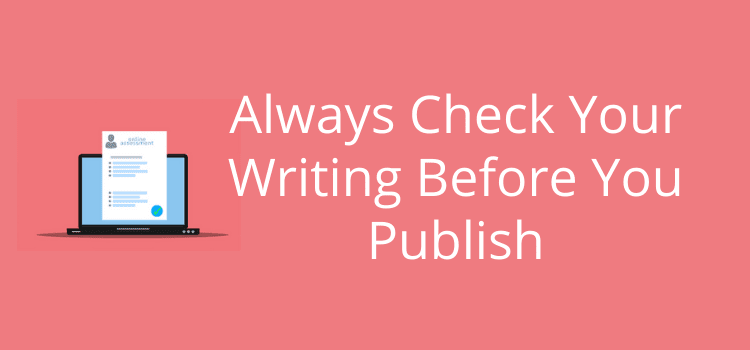
You know you need to check your writing before publishing an article, a blog post, or a book.
However, effective checking involves much more than grammar and spelling checking. You want to make sure that your text reads well and keeps a reader’s attention.
To achieve this, the flow or order of your content is crucial, as well as covering all the essential points. It should also be visually appealing.
Every time you publish something new, you’re not just sharing information but also building your brand and attracting new readers. That’s why meticulous checking is crucial.
10 Point check for your writing
Almost every writer today uses online tools like a writing checker.
These tools make it quick and easy to check the grammar, spelling, and punctuation of any text.
But even if you pass the test on all these fronts, it doesn’t mean you wrote a fantastic piece.
Yes, you need to correct your writing to eliminate typos and grammatical errors.
However, the substance, style, and look of your writing are of much higher value because these elements attract readers.
You only have a few seconds to convince a reader that what you wrote is worth reading.
So, you need to make it instantly appealing with a great headline or title and perhaps a header image.
On top of that, your opening few words of the first sentence must get to the point and grab a reader’s attention.
Before you publish your next piece, think about the following ten points to help you check that your writing is top-class.
If you can tick every item in the list, you will have a much better chance of finding and engaging with new readers.
1. Did you cover everything?
No matter what your topic is, it’s easy to miss one or two essential elements.
If you are writing about buying a Corvette, perhaps you didn’t mention insurance, the cost of spare parts, or clubs you can join.
The easiest way to check is to search for high-ranking articles on your topic.
You are not going to copy, of course. But by quickly scan reading three or four articles, you can make a list of the topic points you might have missed covering.
I always do this before I start writing a new piece. It’s the quickest way to make an outline list of the key points I need to cover in a new article.
2. Change the passive to active voice
Most grammar checkers will warn you about passive sentences in your writing, and one of the best is the Hemingway editor.
You can’t always replace every occurrence. But it’s always good practice to change as many passive sentences as you can to active voice.
It’s much better to say Sam built the house in 1971 than the house was built in 1971.
Getting into the habit of changing from passive to active voice is an essential writing skill.
3. Check for weak verbs
Try to find strong verbs to replace any weaker ones in a text during your check.
A good example is the verb to run. You could replace it with sprinted, raced, darted, or rushed.
Another weak verb is to get. It’s usually very easy to replace it with obtain, fetch, become, or buy.
4. Remove filler words and phrases
Filler words say nothing.
You can’t remove them all, but use them in small doses.
Some of the most common filler words and phrases include:
Basically
For what it’s worth
At the end of the day
Right
Very
Well
I guess
Literally
Sometimes, we use these words by habit. But if you are aware of them, you can reduce your use considerably.
5. Watch out for cliches
Like filler words, cliches tend to say very little and add no real value to your writing.
Try to find better ways to communicate your point.
Some typical cliches include:
What doesn’t kill you makes you stronger
Kiss and make up
Ignorance is bliss
You can’t judge a book by its cover
You can’t please everyone
It’s always better to look for ways to make your point in your own words.
6. Check your formatting
You can ruin a great piece of writing with poor formatting.
Always look to make your text as readable as possible and pleasing to a reader’s eye.
Think about your font color and size and any background you might have. But generally, very dark gray text on a white or pale background usually works well for screen reading.
Also, check your paragraphs and make sure they are not huge blocks of text.
The simple rule of formatting is to make it look great.
7. Proofread carefully
Never take shortcuts when you start the proofreading stage.
If you can, leave your text until the next day before your start so your mind is fresh and alert.
And once is never enough. You should proofread your text at least three times before you publish it.
Even better is to ask someone to help you. A new pair of eyes is always well worthwhile for proofreading.
8. Select and optimize your images
Be selective when you want to include images in an article or blog post.
Don’t add them unless they bring extra value to your piece.
You can always find free stock photos and images, but original photos, graphs, or infographics are much better.
Finally, make sure you optimize your images so they are as small as possible and will load quickly.
9. Edit for SEO
When you are writing an article to publish online, you can help it with some basic search engine optimization (SEO) elements.
a. Use your keyword phrase in your title and the first paragraph.
b. Include your keyword phrase a couple of times in your text.
c. Add alt text tags to your images.
d. Include a couple of outbound links
e. Include internal links if you are publishing on your blog.
You don’t need to be an expert, but a little SEO knowledge can help your articles rank better on search engines.
10. Check your facts
Never rely on your memory for facts you include in your text. Another trap is using AI-generated text.
AI is well known for hallucinating or inventing facts or statistics, so never trust it.
Always double-check and make sure what you say is accurate and correct.
If you are not 100% sure, research or search online to find reliable sources that can verify your facts.
Summary
When you check your writing, you want to add or include improvements to make it more appealing to readers.
Writing articles or a book is hard work, yet the real work begins when you start checking.
Grammar and spelling mistakes, as well as typos, are easy to fix. But thinking about your readers and whether your writing will interest them is not so easy.
You need to analyze every element of your text from a reader’s perspective.
Does it fully inform them? Is it easy to read? Does it look appealing? Am I talking to or at the reader? What point of view am I using?
When you ask yourself these types of questions, you know that you are taking the right approach when checking a new text.
Related reading: When Do You Need To Spell Out Numbers In Full In Your Writing?



